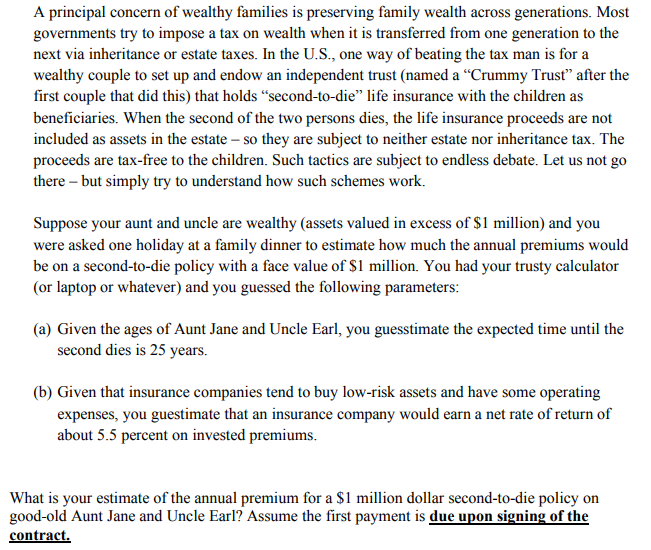
A principal concern of wealthy families is preserving family wealth across generations. Most governments try to impose a tax on wealth when it is transferred from one generation to the next via inheritance or estate taxes. In the U.S., one way of beating the tax man is for a wealthy couple to set up and endow an independent trust (named a "Crummy Trust" after the first couple that did this) that holds "second-to-die" life insurance with the children as beneficiaries. When the second of the two persons dies, the life insurance proceeds are not included as assets in the estate - so they are subject to neither estate nor inheritance tax. The proceeds are tax-free to the children. Such tactics are subject to endless debate. Let us not go there - but simply try to understand how such schemes work. Suppose your aunt and uncle are wealthy (assets valued in excess of $1 million) and you were asked one holiday at a family dinner to estimate how much the annual premiums would be on a second-to-die policy with a face value of S1 million. You had your trusty calculator (or laptop or whatever) and you guessed the following parameters (a) Given the ages of Aunt Jane and Uncle Earl, you guesstimate the expected time until the second dies is 25 years. (b) Given that insurance companies tend to buy low-risk assets and have some operating expenses, you guestimate that an insurance company would earn a net rate of return of about 5.5 percent on invested premiums What is your estimate of the annual premium for a $1 million dollar second-to-die policy on good-old Aunt Jane and Uncle Earl? Assume the first payment is due upon signing of the contract. A principal concern of wealthy families is preserving family wealth across generations. Most governments try to impose a tax on wealth when it is transferred from one generation to the next via inheritance or estate taxes. In the U.S., one way of beating the tax man is for a wealthy couple to set up and endow an independent trust (named a "Crummy Trust" after the first couple that did this) that holds "second-to-die" life insurance with the children as beneficiaries. When the second of the two persons dies, the life insurance proceeds are not included as assets in the estate - so they are subject to neither estate nor inheritance tax. The proceeds are tax-free to the children. Such tactics are subject to endless debate. Let us not go there - but simply try to understand how such schemes work. Suppose your aunt and uncle are wealthy (assets valued in excess of $1 million) and you were asked one holiday at a family dinner to estimate how much the annual premiums would be on a second-to-die policy with a face value of S1 million. You had your trusty calculator (or laptop or whatever) and you guessed the following parameters (a) Given the ages of Aunt Jane and Uncle Earl, you guesstimate the expected time until the second dies is 25 years. (b) Given that insurance companies tend to buy low-risk assets and have some operating expenses, you guestimate that an insurance company would earn a net rate of return of about 5.5 percent on invested premiums What is your estimate of the annual premium for a $1 million dollar second-to-die policy on good-old Aunt Jane and Uncle Earl? Assume the first payment is due upon signing of the contract







